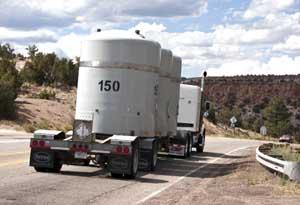Nuclear wasteLos Alamos lab accelerates shipment of nuclear waste to permanent storage site
Los Alamos National Laboratory broke its own records in the first year of accelerated shipping effort of nuclear waste from the Lab to permanent disposal facilities located twenty-six miles outside of Carlsbad, New Mexico

Nuclear waste containers bound for WIPP // Source: lanl.gov
In the first year of an effort to accelerate shipments of transuranic (TRU) waste to the Waste Isolation Pilot Plant (WIPP), Los Alamos National Laboratory broke its own record with fifty-nine more shipments than planned, and became one of the largest shippers of this type of nuclear waste in the country. “Our goal this fiscal year was to send 184 shipments to WIPP,” said Lee Bishop, TRU waste manager at the U.S. Department of Energy’s National Nuclear Security Administration Los Alamos Site Office, “and we finished the fiscal year in September with 230 shipments, surpassing Los Alamos’ all-time record by nearly sixty shipments.”
A Los Alamos National Lab release reports that Los Alamos’ previous record was 171 shipments, set last year.
In an agreement between the New Mexico Environment Department and the Department of Energy, Los Alamos has committed to removing 3,706 cubic meters of TRU waste stored above ground by 30 June 2014.
The Laboratory removed 916 cubic meters of waste from its stored inventory this year, more than its goal of 800 cubic meters. It plans to more than double that effort during fiscal year 2013, which begins 1 October, with a goal of shipping 1,800 cubic meters by the end of the fiscal year on 30 September 2013. The final 1,106 cubic meters will be shipped by 30 June 2014.
“We plan to build on the success of our first year and more than double the amount of waste that we ship in 2013,” said Dan Cox, deputy associate director of environmental programs at Los Alamos.
“A lot of people have worked together to make the first year of this effort a success, including the state, the Department of Energy, WIPP and the Laboratory,” said Pete Maggiore, assistant manager for environmental operations at the NNSA Los Alamos Site Office. “We exceeded our goals and are on track to double both volume and shipments this coming year.”
The release notes that TRU waste consists of clothing, tools, rags, debris, soil, and other items contaminated with radioactive material, mostly plutonium. Transuranic elements such as plutonium have an atomic number greater than uranium, so they are labeled transuranic, for “beyond uranium” on the periodic table of elements.
About 90 percent of the current TRU waste inventory is a result of decades of nuclear research and weapons production at the Laboratory. It is often referred to as “legacy” waste.
The DOE Waste Isolation Pilot Plant facility is designed safely to isolate defense-generated TRU waste from people and the environment. Waste temporarily stored at sites around the country is shipped to WIPP and permanently disposed in rooms mined out of an ancient salt formation 2,150 feet below the surface. WIPP began waste disposal operations in 1999. The facility is located twenty-six miles outside of Carlsbad, New Mexico.
